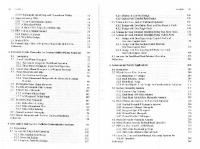Radiowave propagation and antennas for personal communications [3rd ed.] 9781596930735, 159693073X
This newly revised and expanded edition of the Artech House classic, "Radiowave Propagation and Antennas for Person
314 107 5MB
English Pages 500 Year 2007
Recommend Papers
![Radiowave propagation and antennas for personal communications [3rd ed.]
9781596930735, 159693073X](https://ebin.pub/img/200x200/radiowave-propagation-and-antennas-for-personal-communications-3rdnbsped-9781596930735-159693073x.jpg)
- Author / Uploaded
- Kazimierz Siwiak
- Yasaman Bahreini
- Similar Topics
- Technique
- Electronics: Telecommunications
File loading please wait...
Citation preview
Radiowave Propagation and Antennas for Personal Communications Third Edition
For a complete listing of the Artech House Mobile Communications Library, turn to the back of this book.
Radiowave Propagation and Antennas for Personal Communications Third Edition
Kazimierz Siwiak Yasaman Bahreini
artechhouse.com
Library of Congress Cataloging-in-Publication Data A catalog record of this book is available from the Library of Congress.
British Library Cataloguing in Publication Data A catalogue record of this book is available at the British Library.
ISBN 13: 978-1-59693-073-5
Cover design by Igor Valdman
© 2007 ARTECH HOUSE, INC. 685 Canton Street Norwood, MA 02062 All rights reserved. Printed and bound in the United States of America. No part of this book may be reproduced or utilized in any form or by any means, electronic or mechanical, including photocopying, recording, or by any information storage and retrieval system, without permission in writing from the publisher. All terms mentioned in this book that are known to be trademarks or service marks have been appropriately capitalized. Artech House cannot attest to the accuracy of this information. Use of a term in this book should not be regarded as affecting the validity of any trademark or service mark.
10 9 8 7 6 5 4 3 2 1
To my family for their support and guidance, my mom for teaching me patience, and my dad for teaching me perseverance. —Yassi Moim Rodzicom Janowi i Bronislawie – Kai
Contents Preface to the First Edition
ix
Preface to the Second Edition
xiii
Preface to the Third Edition
xvii
1
Introduction
1
1.1
Introduction and Historical Perspective
1
1.2
Personal Communications
3
1.3
Electromagnetics Fundamentals
5
1.3.1
Maxwell’s Equations
8
1.3.2
Boundary Conditions
10
1.3.3
Vector and Scalar Potentials
11
1.3.4
Radiation from a Sinusoidally Excited Current Element
12
1.3.5
Duality in Maxwell’s Equations
14
1.3.6
Current Loop for Sinusoidal Excitation
16
1.3.7
Radiation of a UWB Elementary Dipole and Loop
16
1.3.8
Radiation Zones
20
1.4
Basic Radiowave and Antenna Parameters
23
1.5
Summary
30
Problems References
30 35
vii
viii
Radiowave Propagation and Antennas for Personal Communications
2
Fixed-Site Antennas
37
2.1
Introduction
37
2.2
Antennas as Arrays of Current Sources
39
2.3
Pattern Multiplication and Array Factor
39
2.4
Collinear Antennas and Vertical-Plane Pattern Control
40
2.5
Directivity and Beam Width for Omnidirectional Antennas
41
2.6
Array Antennas
42
2.6.1
Collinear Array and Fourier Transform
43
2.6.2
Horizontal-Plane Pattern Directivity
44
2.6.3
Aperture Antennas: Two-Dimensional Transforms
45
2.7
Pattern Shaping of High-Gain Collinear Antennas
46
2.8
Multiple-Beam Antennas
49
2.8.1
Matrix-Fed Multiple-Beam Antenna Designs
50
2.8.2
Smart Antennas
51
2.9
Proximity Effects in Antennas
53
2.9.1
Treating Scatterers as Infinitely Long Cylinders
53
2.9.2
Modeling the Finite-Length Scatterer
55
2.9.3
Measured and Calculated Patterns Involving Cylindrical Scatterers
57
Application to an Antenna Mounted on the Side of a Tower
57
2.9.4 2.9.5
Effect of Antenna Distortion on Coverage Range
61
2.9.6
Parasitically Driven Array Antennas
61
2.10
Indoor Fixed Sites
65
2.10.1
Wireless Local-Area Network Fixed Sites
66
2.10.2
Gain Antennas for UWB Pulses
66
2.11
Summary
68
Problems References
69 73
3
Radio Communication Channel
77
3.1
Introduction
77
Contents
ix
3.2
Guided Waves
78
3.2.1
Losses in Dielectrics
78
3.2.2
Losses in Conductors
80
3.2.3
Coaxial Transmission Lines
81
3.2.4
Parallel Transmission Lines
84
3.2.5
Minimum Attenuation in Transmission Lines
85
3.2.6
Summary of Transmission Line Relationships
86
3.2.7
Optical Fiber Transmission Lines
86
3.3
Basic Radiowave Propagation
87
3.3.1
Friis Transmission Formula
88
3.3.2
Comparison of Guided Wave and Radiowave Propagation Attenuation
89
3.4
Wave Polarization
90
3.4.1
Polarization of Antennas
90
3.4.2
Polarization Characteristics of Antennas
91
3.4.3
Polarization Mismatch in Antennas
91
3.4.4
Polarization Filtering: An Experiment in Optics
92
3.4.5
Polarization Scattering and the Radar Equation
93
3.5
Summary
94
Problems References
95 98
4
Radio Frequency Spectrum
99
4.1
Introduction
99
4.2
Extremely Low and Very Low Frequencies (> dl ) from the region of the current source I. The solution to the radiation problem of the half-wave dipole, particularly one of finite wire thickness, is inordinately complex and has been extensively investigated [9–13]; most often, approximate solutions [6–8] are satisfactory. Appendix A presents the FORTRAN code based on [13] for computing the currents on, and the fields close to (within a wire diameter), dipoles and helical dipoles having finite thickness. For most purposes here, especially when the detail of the fields very near the dipole conductor are not of interest, the half-wave dipole may be modeled by a sinusoidal current on a very thin wire, as seen in Chapter 11. 1.3.5
Duality in Maxwell’s Equations
Once a solution for an electromagnetics problem is found, a related solution may be found by exploiting the dual nature of Maxwell’s equations. For example, (1.1) and (1.2) are mathematical duals of each other, and their variables are dual quantities when a “magnetic current” M is subtracted from the right-hand side of (1.1). It must be emphasized that the magnetic current M is a mathematical abstraction, which enables us to study Maxwell’s equations as dual quantities. No magnetic currents are presently know to exist in nature, but equivalent magnetic currents arise when we apply volume or surface equivalence theorems. Table 1.2 lists the dual equations for electric- and magnetic-current harmonic
Introduction
15
Table 1.2 Electric and Magnetic Dual Equations for Harmonic Waves Electric Sources, J
Magnetic Sources, M
∇ × E = − jωµo H
∇ × H = jωε o E
∇ × H = jωε o E + J
−∇ × E = − jωµo H + M
∇ 2 A + k 2 A = − µo J
∇ 2F + k 2F = − ε o M
A=
µo e − jkr J 4π r
F =−
µo H = ∇ × A E = − jωA −
ε o e − jkr M 4π r
ε o E = −∇ × F 1
ωµo ε o
∇( ∇ ⋅ A)
H = − jωF −
1 ωµo ε o
∇( ∇ ⋅ F )
wave sources. Care must be exercised when the sources are not sinusoidal, as will be shown later. The dual quantities are given in Table 1.3. The wave number k remains invariant in the dual equations. The principal of duality is sometimes applied to problems of radiation from apertures such as open-ended waveguides, radiating slots, and edges of microstrip patch antennas. The surface across which the radiating electric field exists is replaced by a perfect conductor across which a magnetic current M exists, oriented in a direction perpendicular to the electric field. This surface current then gives rise to radiated fields, which are found using the dual equations in the same way as would they would be determined from an electric surface current J. Table 1.3 Electric and Magnetic Dual Quantities and Variables Electric Sources, J
Magnetic Sources, M
E
H
H
–E
J
M
A
F
o
o
o
o
o
1/
o
16
1.3.6
Radiowave Propagation and Antennas for Personal Communications
Current Loop for Sinusoidal Excitation
Applying the principal of duality, the infinitesimal current loop consisting of a circulating current I enclosing a surface area S is solved by analogy to the infinitesimal dipole problem solved earlier. The dipole current Idl is replaced by a magnetic current equal to Mz dS = Idl, and when the surface area S = dl/k, the fields due to the infinitesimal loop are then given by 1 kIS − jkr 2 j + e k cos( θ) 2 2π (kr ) 3 (kr )
(1.29)
j 1 kIS − jkr 2 1 sin( θ) e k − + + 2 4π (kr ) 3 kr (kr )
(1.30)
Hr =
Hθ =
E φ = ηo
j kIS − jkr 2 1 sin( θ) e k − 2 4π kr (kr )
(1.31)
where 0 = c 0 is the intrinsic impedance of free space. The electric field equations (1.26) and (1.27) of the infinitesimal dipole have exactly the same form as the magnetic field equations for the infinitesimal loop, while the magnetic field of the dipole (1.28) has exactly the same form as the electric field of the loop—when the excitation is a sinusoidal current. In the case where the loop moment kIS equals the previously presented dipole moment Idl, and the loop and dipole are superimposed, the fields in all space will be circularly polarized. The field of arbitrary-sized circular loop antennas was investigated as early as 1897 with H. C. Pocklington’s [9] study of thin wire loops excited by plane waves. Later, E. Hallén [10] and J. E. Storer [14] considered driven antennas. The close near fields of wire loops are quite complex, especially if the loop wire is fat [15]. Appendix B contains the FORTRAN computer code for a detailed analysis of the current distribution on, and the close near field of (within a fraction of a wire diameter), the fat wire loop antenna for sinusoidal excitation. The computer code, based on [15], provides some detail of the current density around the circumference of the loop wire. 1.3.7
Radiation of a UWB Elementary Dipole and Loop
For UWB signals, the fields surrounding an infinitesimal current element of length ∆h can be derived from the Boit-Savart law, which relates a static current distribution to a magnetostatic field, and generalized by Oleg Jefimenko to time-varying solutions. Some details are given in [16], and the magnetic field, here written in terms a current I(t) oriented along the z-axis, is
Introduction
H D (r ,t ) =
17
∆h sin( θ) I ( τ) 1 ∂ + I ( τ) $ c ∂t 4 πr r
(1.32)
The corresponding electric field is ED (r , t ) =
∆h 4 πε 0 r
I ( τ )dt I ( τ ) ∫ $+ sin ( θ) $ + sin( θ ) ∂ I ( τ )$ θ r 2 + cos( ) cr r 2 c 2 ∂t
(
)
(1.33)
where = t r/c is the time-distance retardation term. The 1/r3 dependent electrostatic term involves an integration of the current in time and, hence, is a charge accumulation—the expected result for a static electric doublet (capacitor). For the duality to be complete, the magnetic current moment must have the same functional form as the electric dipole moment; thus, we make the substitution 1 ∂ I ( τ) ∆S ⇒ ∆hI ( τ) c ∂t
(1.34)
where ∆S is the infinitesimal loop area in the x-y plane surrounded by the loop current. Thus, the infinitesimal loop fields for the same source current in the loop as in the dipole are E L (r ,t ) =
∆S sin( θ) ∂ I ( τ) ∂ 2 I ( τ) + 2 2 $ 4 πε 0 rc ∂ t rc ∂t c
(1.35)
and the corresponding electric field is H L (r , t ) =
∆S 4 πr
I ( τ) ∂ I ( τ) ∂ 2 I ( τ) 2 cos( θ )r$ + sin()$ + sin( θ ) 2 2 $ (1.36) 2 + ∂ t cr ∂t c r
(
)
Only the 1/r terms survive into the far-field radiation region. The induction region fields have 1/r 2 behavior. The 1/r 3 term in (1.36) is the magnetostatic term, which would produce a static solenoidal magnetic field if I(t) were a constant direct current. We see that (1.32) to (1.36) are the general case of (1.26) to (1.28) and (1.29) to (1.31). The dipole and loop fields are not only in space quadrature, but their representations in time are also orthogonal since they are related by a time derivative. This has interesting consequences. The superposition of an infinitesimal loop and dipole with the same current excitation produces a rotating electric field vector everywhere in space for the duration of time that the field vector exists;
18
Radiowave Propagation and Antennas for Personal Communications
hence, it defines circular polarization for UWB pulse transmission. Figure 1.4 portrays the electric far field of a collocated infinitesimal loop and dipole pair with I(t) as an odd function of time. The pulse expands in all radial directions, but viewed along the y-axis, the projection of the E-field on the y-z plane is an even function, while its projection on the x-y plane is an odd function, and the polarization vector appears to rotate in space as it passes a fixed observation point on the y-axis. Figure 1.5 shows the dipole and loop electric field strengths, along with the total amplitude of the circularly polarized signal. Comparing Figures 1.4 and 1.5, we can see that as the signal passes a stationary point in its propagation along the y-axis, it appears to an observer to rotate in a counterclockwise direction. As it does so, the E-field vector magnitude is given by the dotted trace in Figure 1.5. Figure 1.6 shows the shape of the signal that would be received by a linearly polarized antenna for different rotational orientations. The signal shape changes with the rotation angle. This behavior is not as obvious with a time-harmonic signal. In that case, the relative phase of the signal shifts as the receive dipole is rotated, but the signal remains a sinusoid. One of the
Dipole E-field z
Dipole
Loop y Total E-field x
Loop E-field
Figure 1.4 Circularly polarized UWB pulse.
Introduction
19
3
E -field am plitude, m V /m
Total field amplitude 2 1 0 -1 -2 Loop -3
1
1.5
Dipole 2 Time, ns
2.5
3
Figure 1.5 UWB circularly polarized field components.
Receive dipole orientation, deg: 0 45
Received signal amplitude
90 135 180 225 270 315
1
1.5
2 Time, ns
2.5
3
Figure 1.6 Circularly polarized UWB signal received by linearly polarized antenna.
20
Radiowave Propagation and Antennas for Personal Communications
consequences of “suppressing” e j t in the time-harmonic solution is that we tend to suppress our understanding of the physics as well. Equations (1.32) and (1.33) reduce to (1.26) to (1.28) and (1.38) and (1.36) reduce to (1.29) to (1.31), when a sinusoidal current Ie j t jkr is used in place of I( ) in (1.32) to (1.36). UWB current pulses are shown in Chapter 6 and described in [16, 17]. 1.3.8
Radiation Zones
Inspection of (1.32), (1.33), and (1.26) to (1.28) for the dipole and (1.35), (1.36), and (1.29) to (1.31) for the loop reveals a very complex field structure. Components of the fields vary as the inverse third power of distance r, inverse square of r, and the inverse of r. In (1.32), we see that there is a transition point where the energy associated with a pulse I(t) equals the energy associated with r/c times the energy associated with the time derivative of the pulse. We will see in Chapter 6 that the energy associated with the time derivative of a UWB pulse is very nearly equal to c2 times the energy associated with a UWB pulse, where frequency c is the geometrical center frequency of the UWB pulse energy. In fact, as the pulse becomes narrower and narrower in bandwidth (its time representation approaches a sinewave), the two become equal, which is the harmonic wave solution (see [17]). Our discussion, then, continues for the sine wave solution. In the near field or induction region of the idealized infinitesimal loop (but for r >> Sk for the loop and r >> dl for the dipole), for kr









